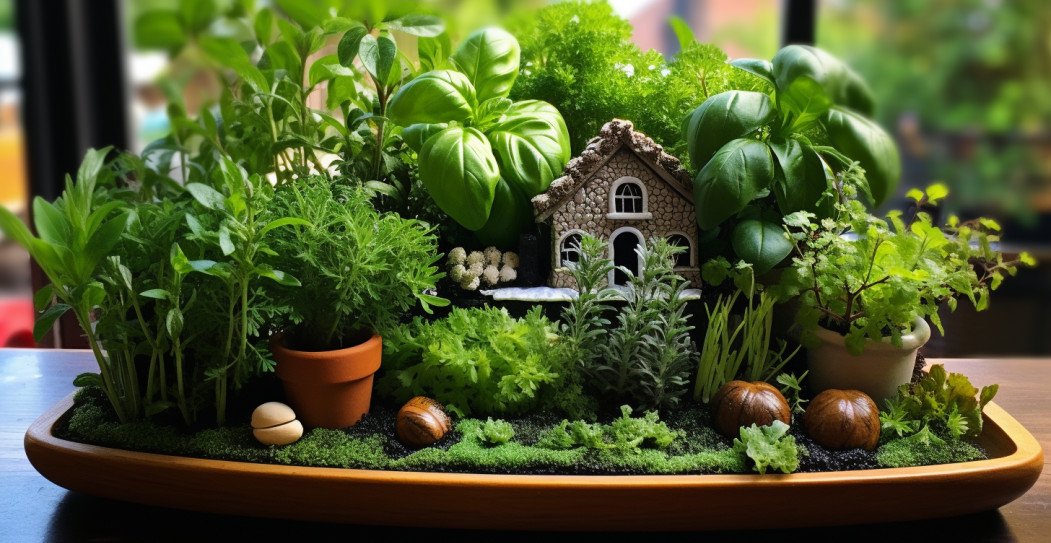If you are lucky enough to have a sunny spot such as a windowsill, a patch outside your kitchen window, a balcony or just in the backyard, then growing these ten culinary herbs will add taste and health to your meals.
Coriander (Coriandrum sativum)
Coriander is a staple ingredient in many cuisines worldwide. It’s used in both its fresh leaf form (cilantro) and dried seed form. It adds flavour to a wide range of dishes, including soups, stews, curries, salads, salsas, and marinades. Ground coriander is a key spice in Indian and Middle Eastern cooking.
Mint (Mentha)
Mint is a versatile herb used in both savoury and sweet dishes. Some common culinary uses of mint include flavouring teas and garnishes. Mint can be added to various dishes, including salads, sauces, marinades, and desserts.
Sage (Salvia officinalis)
Sage, is a fragrant and flavourful herb that has been used for culinary, medicinal, and aromatic purposes for centuries.
It is a versatile herb used in a variety of culinary applications, particularly in Mediterranean and Italian cuisine. Some common culinary uses of sage include seasoning, sauces and gravies, frying and teas.
Oregano (Origanum Vulgare)
Oregano is a staple herb in Mediterranean, Italian, and Greek cuisines. It is used in various culinary applications. Oregano is a classic topping for pizzas and a key ingredient in pasta sauces. It is used to season a wide range of dishes, such as roasted meats, grilled vegetables, soups, and stews. Oregano can be added to salad dressings for extra flavour, and it is often used in marinades.
Rosemary (Rosmarinus officinalis)
Rosemary is a popular culinary herb, particularly in Mediterranean cuisine. It is known for enhancing the flavour of various dishes and is commonly used to add flavour to grilled vegetables, it pairs well with roasted meats, especially lamb and poultry, is used to flavour bread, focaccia, and savoury baked goods and can be added to soups and stews for extra depth of flavour.
Chives (Allium)
Chives are of the Allium family, which includes onions, garlic, and leeks. Chives are valued for their mild onion-like flavour and are commonly used in cooking, garnishing, and as a decorative plant.
They are commonly used as a garnish for salads, soups, baked potatoes, and various other dishes. Chopped chives can be used to season and enhance the flavour of egg dishes, dips, sauces, and creamy dressings and are a great addition to omelets, scrambled eggs, and quiches.
Dill (Anethum graveolens)
Dill, is a flavourful and aromatic herb known for its feathery green leaves and distinctive taste. It is a popular culinary herb with a variety of culinary uses. Dill is a classic ingredient in pickling brines, especially for cucumbers (dill pickles). It pairs well with fish and seafood, both as a seasoning and garnish. Dill leaves can be added to salads, particularly those with cucumbers or potatoes. Dill is a key ingredient in various sauces, including tzatziki and gravlax sauce.
Parsley (Petroselinum crispum)
A versatile and widely used herb that is known for its fresh and vibrant flavour.
Parsley is frequently used as a garnish for a variety of dishes to add colour and a fresh, herbal element. It is used to flavour soups, stews, sauces, and various savoury dishes. It is a common ingredient in salads, particularly tabbouleh, a Middle Eastern salad. Parsley is an essential component of herb blends like fines herbes and bouquet garni.
Basil (Ocimum basilicum)
Basil, is a popular and fragrant herb known for its sweet and aromatic leaves. It is a highly versatile herb used in a wide range of culinary applications.
Basil is the key ingredient in the classic Italian sauce, pesto, made with basil, garlic, pine nuts, Parmesan cheese, and olive oil. It pairs wonderfully with tomatoes, making it a common ingredient in caprese salads, tomato sauces, and margherita pizza. Basil can be added to soups, stews, and various pasta and curry dishes for flavour and aroma. Basil leaves are often used as a fresh garnish on dishes, particularly in Thai cuisine.
Thyme (Thymus vulgaris)
Thyme, is a fragrant and flavourful herb known for its aromatic leaves and culinary versatility. It’s a common herb in Mediterranean, Middle Eastern, and European cuisines and is prized for its culinary, medicinal, and aromatic properties.
It is used to season a wide range of dishes, such as roasted meats, poultry, seafood, and vegetables. Thyme is often added to sauces, gravies, and soups for depth of flavour. It is a key ingredient in many types of stew.
In conclusion
Having a culinary garden offers a multitude of benefits that extend beyond the mere convenience of having fresh herbs and vegetables at your fingertips. Cultivating your own culinary garden provides an opportunity to connect with nature, develop gardening skills, and instil a deeper appreciation for the food on your plate. It empowers you to take control of the ingredients you use, ensuring they are free from harmful chemicals and at their peak of freshness and flavour. Moreover, a culinary garden encourages creativity in the kitchen, inspiring you to experiment with new recipes and flavours. It fosters a sense of self-sufficiency, reduces food waste, and can lead to cost savings. Most importantly, tending to a culinary garden is a gratifying and therapeutic experience that nourishes both body and soul, making it a rewarding and fulfilling endeavour for any home cook or gardener.
